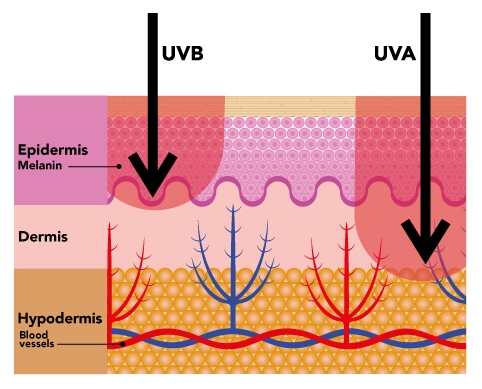Description
Tanning is the process in which skin pigmentation darkens. The colouring occurs as the result of exposure to ultraviolet (UV) radiation from the sun or tanning lamps. It is caused by the formation in the skin of a black pigment called melanin.
Melanin absorbs UV rays. The formation of melanin is a natural reaction to protect the skin against UV rays. The resulting tan is a sign that the skin has reacted after undergoing profound cellular damage. This is why tanned skin should not be associated with health and beauty.
The effect of UV rays
The sun is essential to life. However, excessive exposure to the UV rays it emits can be harmful to your health.
The rays that produce a tan are UVB and UVA.
UVB rays
UVB rays do not penetrate the skin deep as they are generally blocked by the first layer of the skin, which is the epidermis. They cause reddening and burns, which are most commonly called ‘sunburns’.
UVB rays cause the development of new melanin in the skin. They produce a ‘delayed’ tan, which is a tan that appears 48 to 72 hours after exposure to the rays.
The sun is the main source of UVB rays. Artificial tanning lamps can also produce these rays in small quantity.
UVA rays
UVA rays penetrate deep into the skin, thus damaging elastin and collagen fibres. These fibres give the skin elasticity and firmness.
Contrary to UVB rays, UVA rays do not cause the development of new melanin. They activate the melanin that is already in your skin, thereby darkening it.
The UVA rays tan the skin without causing burns. For this reason, artificial tanning lamps mainly emit UVA rays.
Tanning produced with UVA rays is immediately apparent but fades away quickly.

UV penetration into the layers of the skin.
The effect
Along with burns, UV rays can cause damages that accumulate with time. These damages can lead to consequences such as:
- Accelerated aging of the skin (appearance of wrinkles)
- Brown spots
- Eye damage such as cataract
- Weakening of the immune system
- Development of skin cancers
UV rays can also cause the appearance of rosacea. Rosacea is a skin disease that mainly affects the face. It is manifested by the appearance of red spots.
People who naturally produce less melanin are more at risk of such damages. Such people often have the following:
- Pale skin
- Blue eyes
- Blond or red hair
However, as the ozone layer which contributes to protect us is getting thinner, it is becoming more imperative to have protection from the sun and UV rays.
Increase in cases of skin cancer
UV rays cause cancer, whether from the sun or artificial tanning lamps.
The Canadian Cancer Society has estimated that in 2014, over 82,000 people in Canada would be diagnosed with skin cancer, and that 1,500 would die from it.
The deadly toll of melanoma
Melanoma is the deadliest skin cancer. It is one of the most common cancers among young adults.
In the province of Quebec, the number of melanoma cases has doubled since 1990. This increase is not surprising given the increase in tanning salon visits, especially among young women. Indeed, exposure to UV rays from artificial tanning devices before age 35 increases the risk of developing melanoma by 59%.
Three truths about tanning salons
1. Tanning in a salon is as risky as tanning in the sun
Artificial tanning is particularly damaging to skin. Contrary to popular belief, tanning indoor is no safer than tanning in the sun.
UV rays from tanning beds can be 10 to 15 times more intense than those from the sun. 20 minutes of exposure in a tanning bed may be equal to 2 hours on the beach under the hot midday sun.
Tanning salons mainly use UVA rays. As UVA rays produce a tan that fades rapidly, people who tan in salon are compelled to go back frequently in order to maintain their tan. Also, UVA rays create a false sense of safety as they generally do not cause burns.
2. Tanning in a salon does not offer base protection
Many people think that getting a tan before going on vacation prepares their skin for the sunlight. However, artificial tanning offers no effective protection against eventual sunburns.
In fact, a tan provides only a mild sun protection factor (SPF) of 2 to 4, whereas using a sunscreen with an SPF of 30 or higher is recommended.
Here are the only ways of avoiding a sunburn:
- Wear protective clothing such as a wide-brimmed hat and a long-sleeved-shirt
- Stay in the shade
- Use sunscreen
For more information on protective measures against the sun, read Protection from the sun and UV rays.
3. Tanning salons do not fulfill vitamin D deficiency
Vitamin D is essential to your health. The skin’s production of vitamin D is only activated by UVB rays.
UVA rays emitted by tanning equipment do not prompt the skin to produce vitamin D.
Simple exposure to the rays of the sun for 5 to 15 minutes a day is enough to maintain sufficient intake of vitamin D.
In addition, vitamin D is found in various foods, including:
- Milk and other dairy products
- Fatty fishes such as salmon, trout and mackerel
- Egg yolk
Over the counter vitamin D supplements are also available in pharmacies. They’re recommended for certain people, including the elderly, as their skin produces less vitamin D.
Under 18 prohibited from tanning salons
As of February 11, 2013 in the province of Quebec, a law forbids persons under 18 years of age from using artificial tanning services in a tanning salon.
This law was passed following results from recent scientific studies that clearly showed the health risks of artificial tanning.
For more information, contact 1 855 729‑6688 or consult the Act to prevent skin cancer caused by artificial tanning .
See also
Last update: June 13, 2023


